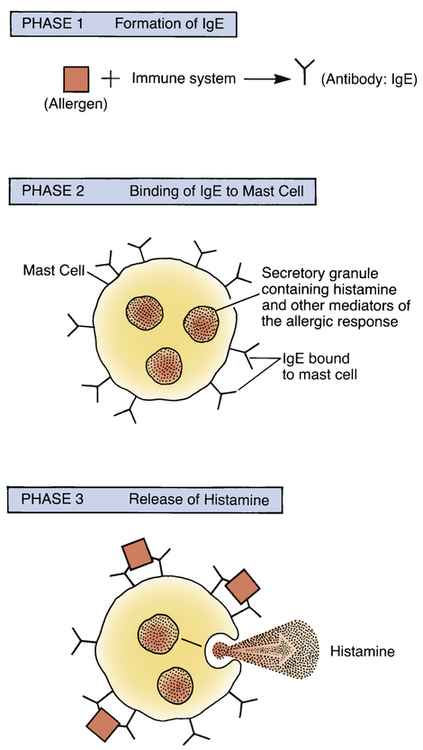CHAPTER 70 The initial requirement for allergic release is production of antibodies of the immunoglobulin E class. These antibodies are generated following exposure to specific allergens (eg, pollens, insect venoms, certain drugs). Once made, the antibodies become attached to the outer surface of mast cells and basophils (Fig. 70–1). When the individual is re-exposed to the allergen, the allergen becomes bound by the antibodies. As indicated in Figure 70–1, binding of allergen to adjacent antibodies creates a bridge between those antibodies. By a mechanism that is not fully understood, this bridging process mobilizes intracellular calcium. The calcium, in turn, causes the histamine-containing storage granules to fuse with the cell membrane and disgorge their contents into the extracellular space. Note that allergic release of histamine requires prior exposure to the allergen; an allergic reaction cannot occur during initial allergen exposure. Severe allergic reactions manifest as anaphylactic shock, a syndrome characterized by bronchoconstriction, hypotension, and edema of the glottis. Although histamine is involved in anaphylaxis, it plays a minor role; other substances (eg, leukotrienes) are the principal mediators. Since histamine has little to do with producing anaphylaxis, it follows that antihistamines are of little help as treatment. The drug of choice for anaphylaxis is epinephrine. The rationale for using epinephrine is discussed in Chapter 17. Antihistamines fall into two basic categories: H1 receptor antagonists and H2 receptor antagonists. The H1 antagonists produce selective blockade of H1 receptors. The H2 antagonists produce selective blockade of H2 receptors. The principal use of H1 blockers is treatment of mild allergic disorders. The principal use of H2 blockers is treatment of gastric and duodenal ulcers. Because H2 antagonists do not block H1 receptors, these drugs are of no use for treating allergies. In this chapter, we focus on H1 antagonists. The H2 blockers, which are important and widely used, are discussed in Chapter 78 (Drugs for Peptic Ulcer Disease). Some antihistamines, such as promethazine [Phenergan] and dimenhydrinate [Dramamine], are labeled for use in motion sickness. Benefits derive from blocking H1 receptors and muscarinic receptors in the neuronal pathway leading from the vestibular apparatus of the inner ear to the vomiting center of the medulla. Motion sickness and its treatment are discussed in Chapter 80. The antihistamines employed for motion sickness, along with their dosages, are listed in Table 80–1. All of the H1 blockers can produce undesired effects. As a rule, these responses are more of a nuisance than a source of serious discomfort or danger. Frequently, side effects subside with continued drug use. Because individual antihistamines differ in their abilities to produce particular side effects (Table 70–1), adverse responses can be minimized by judicious drug selection. TABLE 70–1 Pharmacologic Effects of H1 Antagonists Used for Parenteral Therapy
Antihistamines
Histamine
Distribution, synthesis, storage, and release
Release.
Role of histamine in allergic responses
Severe allergic reactions (anaphylaxis).
The two types of antihistamines: h1 antagonists and h2 antagonists
H1 antagonists i: basic pharmacology
Therapeutic uses
Motion sickness.
Adverse effects

Drug
H1-Blocking Activity*
Sedative Effects*
Anticholinergic Effects*
First-Generation Agents
Alkylamines
Brompheniramine
+ + +
+
+ +
Chlorpheniramine
+ +
+
+ +
Dexchlorpheniramine
+ + +
+
+ +
Ethanolamines
Clemastine
+ to + +
+ +
+ + +
Diphenhydramine
+ to + +
+ + +
+ + +
Phenothiazines
Promethazine†
+ + +
+ + +
+ + +
Piperazines
Hydroxyzine
+ + to + + +
+ + +
+ +
Piperidines
Cyproheptadine
+ +
+
+ +
Second-Generation (Nonsedating) Agents
Cetirizine‡
+ + +
+
±
Levocetirizine‡
+ + +
+
±
Fexofenadine
+ + +
±
±
Loratadine
+ + to + + +
±
±
Desloratadine
+ + to + + +
±
± ![]()
Stay updated, free articles. Join our Telegram channel

Full access? Get Clinical Tree




